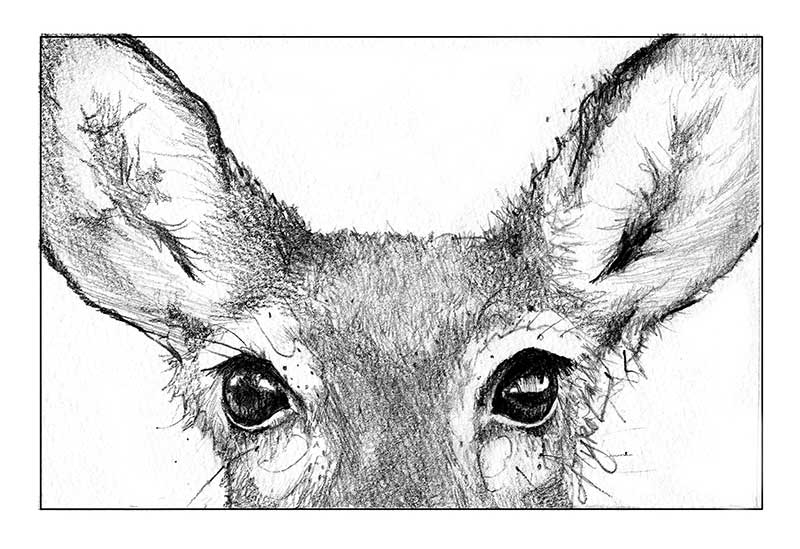What Color Flashlight Can Deer Not See
By Dave Mance III
If you're a hunter who's ever ordered something from a sporting goods company, it's probably safe to assume that you've been so inundated with catalogues over the past four months. God help you if you save your seed catalogues, too.
If you take a moment to flip through your now complete seasonal collection, you might find yourself wondering why during archery season in October the companies were trying to sell you the latest and greatest camo patterns that would make you invisible to deer, but then, during rifle season in November, the same companies tried to sell you glowing blaze orange suits – but don't worry, deer can't see those colors anyway.
Over the years I've had hunters tell me that deer can too see color, and that the conventional deer-are-color-blind thing is a white lie dreamed up by well-meaning government officials who were tired of hunters shooting one and other. (For the record, there is overwhelming evidence that wearing bright colors during rifle season saves human lives, and blaze orange is mandatory in some states.) On the other hand, there's a similar conspiracy theory that holds that maybe it's just the camo clothing companies who are blurring the truth here, as it's in their best interest to sell you two sets of hunting clothes, one for each season.
Fortunately whitetailed deer have been exhaustively studied over the past hundred years, and there's a significant scientific record we can turn to to separate rumor from fact. Deer vision has been studied on a molecular level using DNA cloning, electroretinography, and scanning electron microscopy; it's also been studied in more old school ways using positive and negative stimuli tests on live, captive animals.

Deer vision. Illustration by Adelaide Tyrol.
What researchers have found is that deer can see colors, though they don't experience them in the same way we do. They can pick out short (blue) and middle (green) wavelength colors, but they're less sensitive to long wavelength colors such as red and orange. "They're essentially red-green color blind," said Brian Murphy, a wildlife biologist and the CEO of Quality Deer Management Association. Murphy participated in research done at the University of Georgia in the 1990s, where different wavelengths of light were emitted into the eyes of sedated deer and researchers measured the deer's brainstem responses.
The difference in the way that humans and deer see goes beyond color. Deer have excellent night vision, thanks to eyes with a high concentration of rods, an oval pupal that acts like an aperture on a camera, and a layer of tissue that acts like a mirror and magnifies light. (This tissue, called the tapetum lucidum, is why their eyes glow when you shine a light on them in the dark.) But their eyes have only about half the number of cones that ours do, which affects their daytime and long wavelength color vision.
If you're a hunter or nature photographer who's trying to be inconspicuous in the woods, it seems that the worst color you can wear is blue. Deer eyes lack the ultraviolet light filter that human and other longer-lived animals have, which means they see blues and other short-wavelength colors about twenty times better than we do. "Blue jeans are much more vivid to a deer than blaze orange," said Murphy. Color-conscious outdoorspeople should be aware, too, that clothing companies and laundry detergent manufacturers often add UV dyes and enhancers to their garments and cleaning products, so clothing can take on an ultraviolet glow regardless of color or pattern.
The takeaway seems to be that there's nothing conspiratorial going on when a fish and wildlife department urges hunters to wear orange – in fact, hunters should feel free to wear orange during archery season, too. If you're more inclined towards cool colors, avoid blue and anything that's UV brightened. And if you're a young hunter feeling overwhelmed by the advice being dispensed by clothing manufacturers and the self-appointed experts in the hunting magazines, also keep in mind the big picture here. A deer's sense of smell may be 1,000 times better than ours, their hearing is at least as good as ours, and as a prey species, their brains have been hardwired over millennia to pick up on the slightest movement in the woods and associate it with danger. In short, what color your hunting clothes are is pretty insignificant in the grand scheme of things.
This week's Outside Story feature was written by Dave Mance III, editor of Northern Woodlands magazine. The Outside Story is assigned and edited by Northern Woodlands magazine and sponsored by the Wellborn Ecology Fund of New Hampshire Charitable Foundation. Illustration by Adelaide Tyrol.
What Color Flashlight Can Deer Not See
Source: https://www.nhcf.org/what-were-up-to/what-colors-can-deer-see/